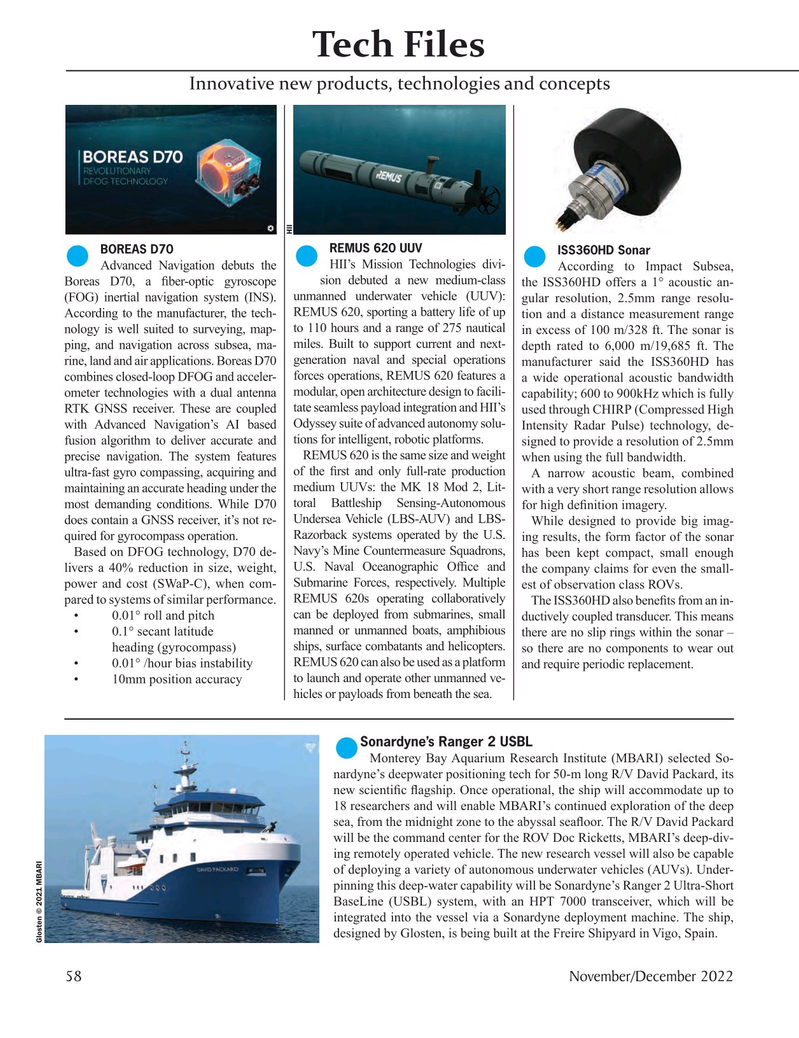
Page 58: of Marine Technology Magazine (November 2022)
Read this page in Pdf, Flash or Html5 edition of November 2022 Marine Technology Magazine
Tech Files
Innovative new products, technologies and concepts
HII
REMUS 620 UUV
BOREAS D70 ISS360HD Sonar
HII’s Mission Technologies divi-
Advanced Navigation debuts the According to Impact Subsea,
Boreas D70, a ? ber-optic gyroscope sion debuted a new medium-class the ISS360HD offers a 1° acoustic an- (FOG) inertial navigation system (INS). unmanned underwater vehicle (UUV): gular resolution, 2.5mm range resolu-
According to the manufacturer, the tech- REMUS 620, sporting a battery life of up tion and a distance measurement range nology is well suited to surveying, map- to 110 hours and a range of 275 nautical in excess of 100 m/328 ft. The sonar is miles. Built to support current and next- ping, and navigation across subsea, ma- depth rated to 6,000 m/19,685 ft. The rine, land and air applications. Boreas D70 generation naval and special operations manufacturer said the ISS360HD has combines closed-loop DFOG and acceler- forces operations, REMUS 620 features a a wide operational acoustic bandwidth ometer technologies with a dual antenna modular, open architecture design to facili- capability; 600 to 900kHz which is fully
RTK GNSS receiver. These are coupled tate seamless payload integration and HII’s used through CHIRP (Compressed High with Advanced Navigation’s AI based Odyssey suite of advanced autonomy solu-
Intensity Radar Pulse) technology, de- fusion algorithm to deliver accurate and tions for intelligent, robotic platforms.
signed to provide a resolution of 2.5mm
REMUS 620 is the same size and weight precise navigation. The system features when using the full bandwidth. ultra-fast gyro compassing, acquiring and of the ? rst and only full-rate production
A narrow acoustic beam, combined medium UUVs: the MK 18 Mod 2, Lit- maintaining an accurate heading under the with a very short range resolution allows most demanding conditions. While D70 toral Battleship Sensing-Autonomous for high de? nition imagery.
Undersea Vehicle (LBS-AUV) and LBS- does contain a GNSS receiver, it’s not re- While designed to provide big imag- quired for gyrocompass operation. Razorback systems operated by the U.S. ing results, the form factor of the sonar
Based on DFOG technology, D70 de- Navy’s Mine Countermeasure Squadrons, has been kept compact, small enough livers a 40% reduction in size, weight, U.S. Naval Oceanographic Of? ce and the company claims for even the small- power and cost (SWaP-C), when com- Submarine Forces, respectively. Multiple est of observation class ROVs.
REMUS 620s operating collaboratively pared to systems of similar performance. The ISS360HD also bene? ts from an in- • 0.01° roll and pitch can be deployed from submarines, small ductively coupled transducer. This means • 0.1° secant latitude manned or unmanned boats, amphibious there are no slip rings within the sonar – heading (gyrocompass) ships, surface combatants and helicopters. so there are no components to wear out
REMUS 620 can also be used as a platform • 0.01° /hour bias instability and require periodic replacement. • 10mm position accuracy to launch and operate other unmanned ve- hicles or payloads from beneath the sea.
Sonardyne’s Ranger 2 USBL
Monterey Bay Aquarium Research Institute (MBARI) selected So- nardyne’s deepwater positioning tech for 50-m long R/V David Packard, its new scienti? c ? agship. Once operational, the ship will accommodate up to 18 researchers and will enable MBARI’s continued exploration of the deep sea, from the midnight zone to the abyssal sea? oor. The R/V David Packard will be the command center for the ROV Doc Ricketts, MBARI’s deep-div- ing remotely operated vehicle. The new research vessel will also be capable of deploying a variety of autonomous underwater vehicles (AUVs). Under- pinning this deep-water capability will be Sonardyne’s Ranger 2 Ultra-Short
BaseLine (USBL) system, with an HPT 7000 transceiver, which will be integrated into the vessel via a Sonardyne deployment machine. The ship, designed by Glosten, is being built at the Freire Shipyard in Vigo, Spain.
Glosten © 2021 MBARI 58 November/December 2022
MTR #8 (50-63).indd 58 11/29/2022 3:16:19 PM

 57
57

 59
59
